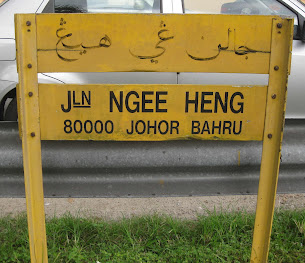 |
| Jalan Ngee Heng remains as a lasting legacy of the Ngee Heng Kongsi in Johor's rich history |
There was a time when the name, Ngee Heng, was spoken in whispers because the notorious reputation of this Teochew brotherhood was once a powerful secret society in Johor Baru.
Clouded by clandestine activities, the workings of this kongsi or society, remained largely misunderstood until recently.
After a comprehensive research on more than 70 years in the history of the Ngee Heng Kongsi, the Johor Baru Chinese Heritage Museum
Over the period of 12 months, the research team collected essential information from their travels to sites where the Ngee Heng society was once active in Mainland China , Singapore , Penang and the Riau Island in Indonesia
From documents and ancient artifacts, they were able to piece together, a picture of how secret societies operated in the 1800s.
Even though the society started as a quasi-military revolutionary brotherhood that was opposed to the Ching dynasty, their activities in Johor Baru gradually evolved into valuable social, political and administrative work which contributed to Johor’s early economic growth.
 |
| A mock-up of an altar with the ritual objects that secret societies used to swear members into the brotherhood |
In 1844, when Temenggong Daeng Ibrahim, the father of Sultan Abu Bakar, invited the Chinese from Singapore
The Teochew clan was the dominant Chinese dialect group who made Johor their new home and they cultivated pepper and gambier plantations in the kangchu system.
When Sultan Abu Bakar recognised the strength and solidarity of a brotherhood like the Ngee Heng society, he legalised it as an association in 1873 with membership opened to all Chinese clans and assigned it to take charge of Chinese community affairs.
Visitors to the exhibition showcased in the museum, will walk pass red cloths that decorate the stairway as a replica of the entrance to the society’s headquarters.
The motivating themes of these inspiring couplets painted on the cloths hint of the obscure origins of the Ngee Heng society that can be traced back to Shaolin monks who were loyal to the Ming emperor.
 |
| Eric Ku, then Deputy General Manager of the JB Tiong Hua Association, looking at some of the exhibits |
After invading Ching armies forced them out from their monastery, the monks reverted to civilian life and vowed to defend their patriotic cause.
As revolutionaries, their activities were largely underground with a tradition of covert activities that used secret codes and languages.
While the characteristics of the society evolved over the years in Johor Baru, it is believed that the Ngee Heng society derived from the Hong Men or Red Door society, a group that developed from the Tian Di Hui or Heaven and Earth society.
When you step into the exhibition hall, your eyes will be riveted to a towering pair of giant mythical birds that the Ngee Heng society adopted as their symbol.
These are believed to be Da Peng Niao, mythical giant creatures that are likened to the Javanese garuda. It is interesting that as far back as 1400, the Chinese emperor of the Ming Dynasty was the first to use the word Peng as an adjective to describe his army as Peng!
 |
| Ngee Heng Kongsi members had a secret code to communicate with hand and body signals |
On a mock altar, there is a host of paraphernalia used for the rituals to swear members into the brotherhood.
You can have a better insight into blood oaths taken in front of an altar by viewing movie snippets in a documentary screened in a section of the exhibit.
“The sworn brothers take this oath very seriously,” said Eric Ku, Deputy General Manager of JB Tiong Hua Association, as he referred to the list of 36 Oaths of the Ngee Heng Kongsi displayed on the wall.
A chart outlined the hierarchy in the brotherhood, listing Da Ke or Big Brother above, overseeing members in several ranks below him with Ma Zai or Little Horses, at the bottom rung.
“Members of the brotherhood are so close that each member considers another brother’s problem as his own,” he added.
 |
| A recent photo of JB Chinese community leaders paying respects at the Ming Tomb |
When Johor became part of the Unfederated Malay States under the British colonial authority in 1914, the kangchu system was abolished and the Ngee Heng kongsi was disbanded.
The society’s assets were dissolved and contributed to charity with a sum set aside to build a tomb for the burial of all their ritual and sacred objects as well as ancestral tablets.
As a mark of respect, JB Chinese community leaders will perform ancestor worship rituals twice a year at this tomb, located close to Jalan Abdul Rahman Andak that is simply adorned by two Chinese characters: Ming Mu meaning Ming Tomb.
 |
| The Ming Tomb in the Chinese cemetery near Jalan Abdul Rahman Andak |
The legacy of Ngee Heng kongsi and its renowned leaders lives on in JB with its name honoured in Jalan Ngee Heng, Kampong Ngee Heng, Ngee Heng Primary School
United with the other Chinese clans as a legal society in JB, they built the Johor Gu Miao, the Ancient or Old Temple , established a common cemetery they called Kongsi San and started the Foon Yew School
The unity among the five Chinese clans in JB marked the birth of an organisation that eventually developed into the JB Tiong Hua Association of today.
The JB Chinese Heritage Museum, located at 42, Jalan Ibrahim, Johor Baru, is open daily from 9am to 5pm and closed on Monday. Entrance fees are RM5 for adult and RM2 for students, children and senior citizens. Tel: 607 – 2249 633, Fax: 607 – 2249 635 or email: heritage_museumjb@jb-tionghua.org.my
Good article about chinese kongsi
ReplyDelete